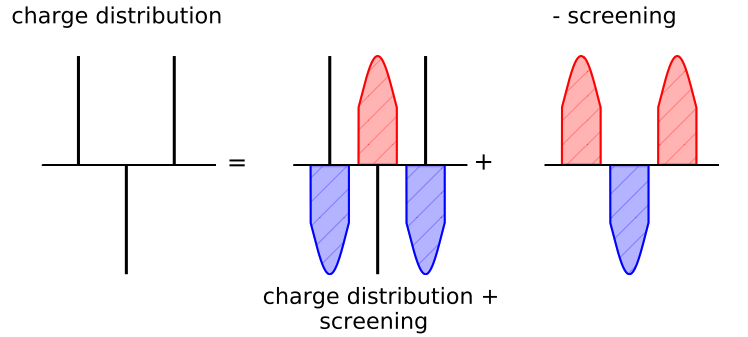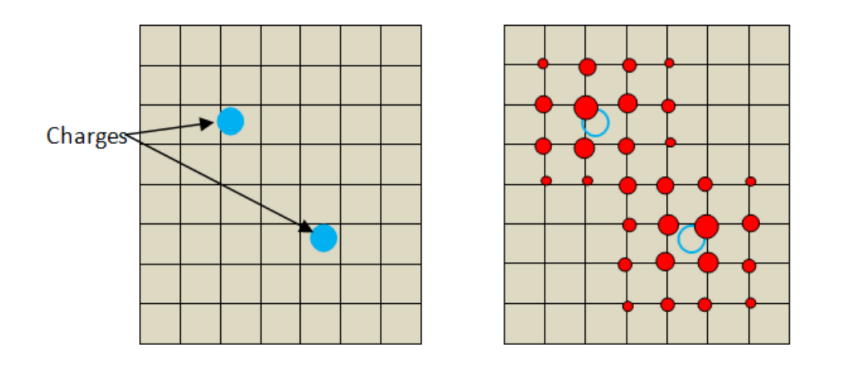Ewald summation#
Background#
Different from the short-ranged interactions, the electrostatic interaction describing by the coulomb law will not vanish beyond specific range for a dense system as:
According to Equation (2), the interaction energy between central particles and their neighboring particles within the range of

Ewald summation is a mathematical method utilized in computational chemistry and physics to precisely calculate the long-range electrostatic interactions between charged particles in a periodic system. The fundamental concept involves transforming the original delta-like charge distribution into the superposition of a screening distribution and a Gaussian-like distribution, as depicted above. The screening distribution is composed of the original distribution and a Gaussian with an opposite charge sign, similar to dipoles. Approximately, the energy is altered to:
As the distance increases, the energy now diminishes. Precisely, the energy of the screening distribution can be expressed as follows:
Moreover, for the Gaussian-like distribution, we can substitute the summation in real space with the summation in reciprocal space, since the Gaussian distribution is periodic owing to the presence of PBC. First, considering the Poisson equation in reciprocal space:
, the electric potential of Gaussian-like distribution in the reciprocal space expresses as:
Next, we utilize the Poisson summation to convert the potential in reciprocal space into real space and give the potential energy:
The summation over
Then the total electric potential energy can be written as:
In practical applications, the Fast Fourier Transform (FFT) algorithm is utilized to hasten the calculation of long-range electrostatic interactions, and its implementation necessitates the discretization (griding) of space. Two common algorithms, namely the the Particle Mesh Ewald [6, 7] (PME) method and Particle-Particle Particle Mesh [8, 9] (PPPM or P3M) method, have been introduced to tackle this issue. In MDPy, the PME method is implemented to evaluate electrostatic interactions.
Particle Mesh Ewald#

Fig. 7 Illustration of: (Right) B-spline interpolation, (Left) Electric potential.#
Ewald coefficient#
As shown in Equation (4), the Ewald coefficient
In MDPy, the Ewald coefficient is calculated by solving Equation (12) via the Newton method.
Bspline interpolation#
As FFT requires a discretization of space, the particles’ charge should be assigned to the grid points. B-spline interpolation is a widely used technique in numerical analysis and computer graphics to approximate complex functions with a smooth curve. It involves constructing a piecewise polynomial function that passes through a given set of control points, while ensuring a high degree of smoothness and continuity between adjacent curves.
B-splines are defined by a set of basis functions, which are polynomial functions of a fixed degree that are defined over a specific interval. By combining these basis functions with a set of control points, a smooth curve can be constructed that accurately approximates the original function.

Fig. 8 Example of charge spreading in 2D for 4th order B-spline; circle sizes signify absolute values of charge contributions [10].#
MDPy employs a 4th order B-spline curve to map the charge to a cubic grid. The above diagram provides a 2D illustration of this process.
Tip
More detailed information can be found in reference [10].